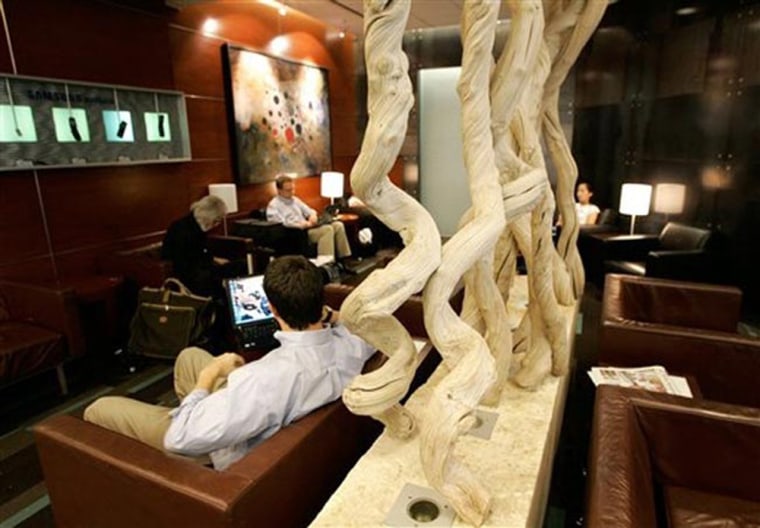American Airlines' then chairman C.R. Smith launched the first VIP airline lounge in 1936 to reward his best customers and supporters, upon whom he bestowed the honorific "Admirals."
Back then, membership was at the discretion of the sales force. Today, however, anyone with enough money can join an airline club. They're expensive, but considering the chaos of the typical airline terminal, especially when flights are delayed or cancelled, they can be well worth it. Airline club lounges are a definite step up from sitting on the floor next to gate, fighting over the last available power outlet.
In addition to comfortable work stations and cushy chairs, they offer perks like free beverages and civil reservation agents. Airfarewatchdog.com details the pros and cons of different kinds of club memberships, and the amenities you get.
Day passes
If you're an infrequent flyer, but still want to wait comfortably and work productively, the best solution is a day pass. Prices, per person, vary: $25 for Delta's Crown Room Club; $45 for Northwest's WorldClub and Continental's President's Club; and $50 for American's Admiral's Club and United's Red Carpet Club. Northwest also offers a 60-day trial membership for $85.
But if there are delays due to weather, admission may be limited and passes won't necessarily be available on-site, so you'll be stuck looking for a table at the Fox Sports nachos 'n beer fun zone with everybody else.
Annual memberships
You can also buy annual club memberships using money or frequent flyer miles. Memberships run from $400 with Delta and Continental, to $450 with American, Northwest and Continental, all the way to $500 with United. "Initiation fees" may also apply, but there are discounts if you're an upper tier member of the airline's frequent flyer program. If you're young and fly a lot, consider a lifetime membership, and pray that your airline doesn't go kaput before you do.
As an added bonus, Delta, Northwest, and Continental offer reciprocal admission to each other's facilities, as well as to a few Alaska Airlines clubs, although there are a few fine-point restrictions.
Amenities vary
For that outlay, you get an open bar in some clubs, snacks, wireless Internet, comfy chairs and two guests. Wi-Fi isn't always free — Admiral's Clubs in the US and Red Carpet Clubs merely offer T-Mobile Hot Spots, although American does have free internet-capable computers — and you'll have to pay for your gin and tonics in the American (domestic), Delta, United and US Airways clubs.
Northwest and Continental offer both free Wi-Fi and alcoholic beverages, making them a good value if you like to surf while you sip.
But another huge perk reveals itself when you need to be rebooked on another flight because yours was cancelled or delayed. Would you rather stand in line with scores of the bumped and grumped, or go to the club, where the lines will be shorter? (Club receptionists are also able to rebook flights and assign seats.) And for some, just having enough power outlets to charge computers and phones is reason enough to join.
It's important to note that airline clubs vary greatly in quality, even within a single airline. One location might be new and spacious, while another might have seen its last refurbishment when the Boeing 707 ruled the skies, with nary a free seat to be found.
Non-airline programs
Then there are the non-airline airport club programs. Priority Pass offers entry to 500 lounges worldwide, many of them not airline affiliated, in airports worldwide (compared to United's Red Carpet Club, which has 40 locations). Membership costs either $99 annually plus $24 a visit or $399 annually for unlimited visits. Guests cost $24 extra.
Unfortunately, there are gaps in Priority Pass-affiliated lounges at a few airports — no one wants to trek to a different terminal for a few free drinks — but most domestic airports are pretty well-covered. For example, in Baltimore you can use the US Airways or United lounges in Concourse D, whereas at Orlando it's United or Delta.
At New York's JFK, there are only two lounges, the United lounge in Terminal 7 and the Korean Airlines lounge in Terminal 1. This presents an obvious problem: if the available airline club is in Terminal A, and you're flying on another airline from Terminal Z, you may not even bother.
A much better deal may be American Express Platinum Card's airport club program, which allows members to use their cards to get into participating Delta, Northwest, Continental and American lounges.
Just show the card to get free access for yourself and up to two guests at 107 locations worldwide, with the caveat that you must be flying on the airline of the lounge that you use that day. This is not the case with Priority Pass.
American Express Platinum cards, whether business or personal, have a $450 yearly fee with no spending limit; essentially it's a combined Delta/Northwest/Continental/American membership, which would otherwise cost the equivalent of $950 (a membership to either Delta, Northwest or Continental plus American), with an attached credit card, albeit a very fancy card with no spending limit and lots of other perks.
Finally, Diners Club cards provide access to more than 80 lounges worldwide for $95 a year. The cards offer access to lounges in some interesting international locations, but at a mere two U.S. airports (Miami and Newark). However, if you find yourself in need of a lounge in Skopje, Macedonia — not traditionally a popular airport for layovers — you're covered.
The bottom line
If you fly just one airline and fly a lot, join that airline's club. Northwest, Delta, and Continental are especially good choices, thanks to reciprocal privileges. But if you fly on American often as well as the aforementioned carriers, the American Express Platinum Card makes sense. Either way, you'll experience less stress, and work more productively. Unless you overdo it with the open bar.
